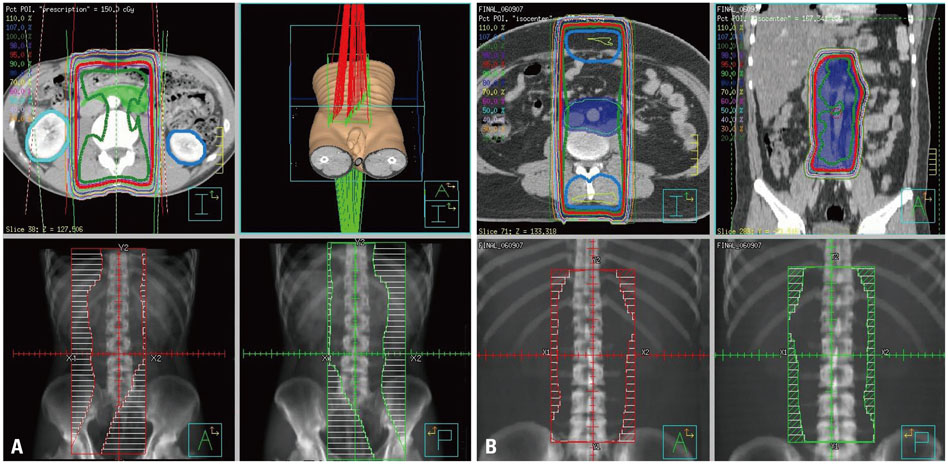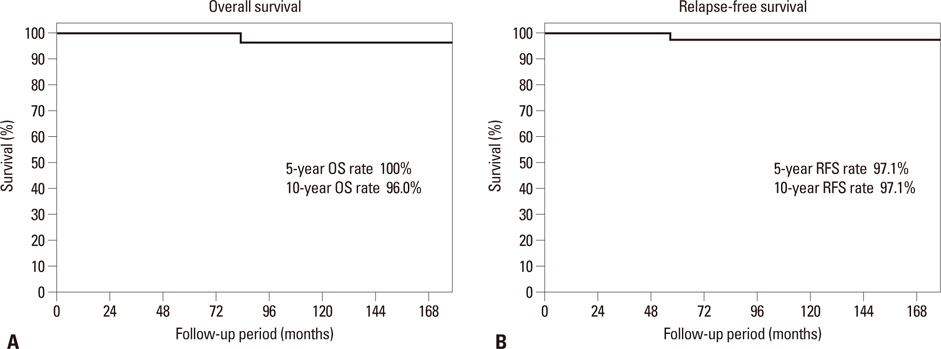Yonsei Med J.
2015 Jan;56(1):24-30. 10.3349/ymj.2015.56.1.24.
Adjuvant Radiotherapy Outcome of Stage I Testicular Seminoma: A Single Institution Study
- Affiliations
-
- 1Department of Radiation Oncology, Yonsei University College of Medicine, Seoul, Korea. jjhmd@yuhs.ac
- 2Department of Urology, Yonsei University College of Medicine, Seoul, Korea.
- KMID: 2352785
- DOI: http://doi.org/10.3349/ymj.2015.56.1.24
Abstract
- PURPOSE
To analyze treatment outcome and side effects of adjuvant radiotherapy using radiotherapy fields and doses which have evolved over the last two decades in a single institution.
MATERIALS AND METHODS
Forty-one patients received radiotherapy after orchiectomy from 1996 to 2007. At our institution, the treatment field for stage I seminoma has changed from dog-leg (DL) field prior to 2003 to paraaortic (PA) field after 2003. Fifteen patients were treated with the classic fractionation scheme of 25.5 Gy at 1.5 Gy per fraction. Other patients had been treated with modified schedules of 25.05 Gy at 1.67 Gy per fraction (n=15) and 25.2 Gy at 1.8 Gy per fraction (n=11).
RESULTS
With a median follow-up of 112 months, the 5-year and 10-year survival rates were 100% and 96%, respectively, and 5-year and 10-year relapse-free survival rates were both 97.1%. No in-field recurrence occurred. Contralateral seminoma occurred in one patient 5 years after treatment. No grade III-IV acute toxicity occurred. An increased rate of grade 1-2 acute hematologic toxicity was found in patients with longer overall treatment times due to 1.5 Gy per fraction. The rate of grade 2 acute gastrointestinal toxicity was significantly higher with DL field than with PA field and also higher in the 1.8-Gy group than in the 1.5-Gy and 1.67-Gy groups.
CONCLUSION
Patients with stage I seminoma were safely treated with PA-only radiotherapy with no pelvic failure. Optimal fractionation schedule needs to be explored further in order to minimize treatment-related toxicity.
MeSH Terms
Figure
Reference
-
1. McGlynn KA, Devesa SS, Sigurdson AJ, Brown LM, Tsao L, Tarone RE. Trends in the incidence of testicular germ cell tumors in the United States. Cancer. 2003; 97:63–70.
Article2. Huyghe E, Matsuda T, Thonneau P. Increasing incidence of testicular cancer worldwide: a review. J Urol. 2003; 170:5–11.
Article3. Jemal A, Siegel R, Ward E, Hao Y, Xu J, Murray T, et al. Cancer statistics, 2008. CA Cancer J Clin. 2008; 58:71–96.
Article4. Tandstad T, Smaaland R, Solberg A, Bremnes RM, Langberg CW, Laurell A, et al. Management of seminomatous testicular cancer: a binational prospective population-based study from the Swedish norwegian testicular cancer study group. J Clin Oncol. 2011; 29:719–725.
Article5. Groll RJ, Warde P, Jewett MA. A comprehensive systematic review of testicular germ cell tumor surveillance. Crit Rev Oncol Hematol. 2007; 64:182–197.
Article6. Oliver RT, Mason MD, Mead GM, von der Maase H, Rustin GJ, Joffe JK, et al. Radiotherapy versus single-dose carboplatin in adjuvant treatment of stage I seminoma: a randomised trial. Lancet. 2005; 366:293–300.
Article7. Pectasides D, Pectasides E, Constantinidou A, Aravantinos G. Stage I testicular seminoma: management and controversies. Crit Rev Oncol Hematol. 2009; 71:22–28.
Article8. Niazi TM, Souhami L, Sultanem K, Duclos M, Shenouda G, Freeman C. Long-term results of para-aortic irradiation for patients with stage I seminoma of the testis. Int J Radiat Oncol Biol Phys. 2005; 61:741–744.
Article9. Jones WG, Fossa SD, Mead GM, Roberts JT, Sokal M, Horwich A, et al. Randomized trial of 30 versus 20 Gy in the adjuvant treatment of stage I Testicular Seminoma: a report on Medical Research Council Trial TE18, European Organisation for the Research and Treatment of Cancer Trial 30942 (ISRCTN18525328). J Clin Oncol. 2005; 23:1200–1208.
Article10. Kamba T, Kamoto T, Okubo K, Teramukai S, Kakehi Y, Matsuda T, et al. Outcome of different post-orchiectomy management for stage I seminoma: Japanese multi-institutional study including 425 patients. Int J Urol. 2010; 17:980–987.
Article11. Mead GM, Fossa SD, Oliver RT, Joffe JK, Huddart RA, Roberts JT, et al. Randomized trials in 2466 patients with stage I seminoma: patterns of relapse and follow-up. J Natl Cancer Inst. 2011; 103:241–249.
Article12. Travis LB, Curtis RE, Storm H, Hall P, Holowaty E, Van Leeuwen FE, et al. Risk of second malignant neoplasms among long-term survivors of testicular cancer. J Natl Cancer Inst. 1997; 89:1429–1439.
Article13. Girinsky T, Ghalibafian M. Radiotherapy of hodgkin lymphoma: indications, new fields, and techniques. Semin Radiat Oncol. 2007; 17:206–222.
Article14. Koshy M, Rich SE, Mahmood U, Kwok Y. Declining use of radiotherapy in stage I and II Hodgkin's disease and its effect on survival and secondary malignancies. Int J Radiat Oncol Biol Phys. 2012; 82:619–625.
Article15. Kleinschmidt K, Dieckmann KP, Georgiew A, Loy V, Weissbach L. Chemotherapy is of limited efficacy in the control of contralateral testicular intraepithelial neoplasia in patients with testicular germ cell cancer. Oncology. 2009; 77:33–39.
Article16. Powles T, Robinson D, Shamash J, Moller H, Tranter N, Oliver T. The long-term risks of adjuvant carboplatin treatment for stage I seminoma of the testis. Ann Oncol. 2008; 19:443–447.
Article17. Fosså SD, Horwich A, Russell JM, Roberts JT, Cullen MH, Hodson NJ, et al. Medical Research Council Testicular Tumor Working Group. Optimal planning target volume for stage I testicular seminoma: a Medical Research Council randomized trial. J Clin Oncol. 1999; 17:1146.
Article18. Gordon W Jr, Siegmund K, Stanisic TH, McKnight B, Harris IT, Carroll PR, et al. Southwest Oncology Group. A study of reproductive function in patients with seminoma treated with radiotherapy and orchidectomy: (SWOG-8711). Int J Radiat Oncol Biol Phys. 1997; 38:83–94.
Article
- Full Text Links
- Actions
-
Cited
- CITED
-
- Close
- Share
- Similar articles
-
- An Unusual Case of Testicular Seminoma Mimicking Segmental Testicular Infarction
- A Case Report of Testicular Seminoma
- Spermatocytic Seminoma With Sarcoma: An Indication for Adjuvant Chemotherapy in Localized Disease
- Advanced Seminoma Resulted From Suprapubic Ectopic Testis
- Radiation Therapy of Testicular Seminoma



